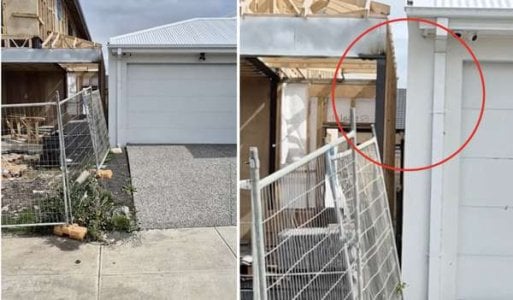Trade professional exposes a worrying trend in new homes – here's what you need to watch out for!
By
Seia Ibanez
- Replies 9
The dream of owning a brand-new home is one that many Australians hold dear. The allure of pristine walls, untouched gardens, and the promise of a fresh start is hard to resist. However, a concerning trend in the construction industry is turning that dream into a potential nightmare for some homeowners. As we've recently learned, not all new builds are created equal, and the details can make a significant difference in the quality and legality of a construction project.
A Melbourne building inspector has sounded the alarm on a half-finished home in Sunbury, where the garage is so close to the neighbouring property that it's nearly impossible to complete the construction. This isn't just a minor inconvenience; it's a glaring example of a worrying trend in housing developments across Australia.

Jim Zacharias, a Victorian man who works as an excavator operator, shared a video online that showcased the problematic proximity of the two homes. The footage revealed the two garages side by side, with barely any space between them. 'How do you brick it?' Zacharias asked, highlighting the impracticality of the situation. 'What's happening here?' he questioned, voicing the confusion and frustration that many in the industry and potential homeowners feel when faced with such oversights.
This isn't an isolated incident. Zacharias pointed out that he's seen many similar cases in subdivisions around the country. The issue is so prevalent that it's raising questions about the declining standards in the Australian building sector.
Zeher Khalil, a prominent building inspector, expressed doubts about how the Sunbury project could be completed given the current state. He speculated that the builders might resort to installing hebel panels, but even that solution seemed unlikely to work. Khalil suggested that the builder might have rushed the process to get paid for the frame stage, a practice that is unfortunately not uncommon.
Builders are typically paid in stages: base, frame, lock-up and fix, and final. Cutting corners to move to the next payment stage can lead to significant problems down the line, as evidenced by the 'complete shemozzle' that Khalil described.
The decline in building standards isn't just a matter of inconvenience; it can have serious financial and legal repercussions for homeowners. We've seen instances where Australians have had to spend considerable amounts of money to rectify construction blunders. In NSW, a resident discovered their neighbour's home was built on the boundary line. In another case, a family had to modify their brand-new home significantly after it was built too close to the property next door.
On the Gold Coast, Kathy Morin and Devon Matsalla faced delays in their home's construction because the neighbouring property was built so close that scaffolding couldn't be erected between the two structures. An investigation by the Gold Coast City Council found that the neighbour's building plans violated setback requirements.
These stories serve as a cautionary tale for anyone looking to buy or build a new home. It's crucial to ensure that your builder is reputable and that all construction complies with local regulations and standards. Before signing any contracts, do your due diligence: check references, review previous projects, and ensure that all building permits and plans are in order.
If you're already in a situation where you suspect your home may not meet the required standards, it's important to act quickly. Contact your local council or a building inspector to assess the situation. You may also need to seek legal advice to understand your rights and the potential remedies available to you.

At the Seniors Discount Club, we understand that navigating the complexities of home ownership can be daunting, especially when faced with potential construction issues. That's why we encourage our members to share their experiences and tips in the comments below. Have you encountered similar problems with a new build? How did you handle it? Your insights could help fellow Australians avoid the pitfalls of a poorly constructed home.
A Melbourne building inspector has sounded the alarm on a half-finished home in Sunbury, where the garage is so close to the neighbouring property that it's nearly impossible to complete the construction. This isn't just a minor inconvenience; it's a glaring example of a worrying trend in housing developments across Australia.

Tradie Jim Zacharias saw this dody build in homes, and said it is a growing issue in Australia. Credit: @jim.zacharias / TikTok
Jim Zacharias, a Victorian man who works as an excavator operator, shared a video online that showcased the problematic proximity of the two homes. The footage revealed the two garages side by side, with barely any space between them. 'How do you brick it?' Zacharias asked, highlighting the impracticality of the situation. 'What's happening here?' he questioned, voicing the confusion and frustration that many in the industry and potential homeowners feel when faced with such oversights.
This isn't an isolated incident. Zacharias pointed out that he's seen many similar cases in subdivisions around the country. The issue is so prevalent that it's raising questions about the declining standards in the Australian building sector.
Zeher Khalil, a prominent building inspector, expressed doubts about how the Sunbury project could be completed given the current state. He speculated that the builders might resort to installing hebel panels, but even that solution seemed unlikely to work. Khalil suggested that the builder might have rushed the process to get paid for the frame stage, a practice that is unfortunately not uncommon.
Builders are typically paid in stages: base, frame, lock-up and fix, and final. Cutting corners to move to the next payment stage can lead to significant problems down the line, as evidenced by the 'complete shemozzle' that Khalil described.
The decline in building standards isn't just a matter of inconvenience; it can have serious financial and legal repercussions for homeowners. We've seen instances where Australians have had to spend considerable amounts of money to rectify construction blunders. In NSW, a resident discovered their neighbour's home was built on the boundary line. In another case, a family had to modify their brand-new home significantly after it was built too close to the property next door.
On the Gold Coast, Kathy Morin and Devon Matsalla faced delays in their home's construction because the neighbouring property was built so close that scaffolding couldn't be erected between the two structures. An investigation by the Gold Coast City Council found that the neighbour's building plans violated setback requirements.
These stories serve as a cautionary tale for anyone looking to buy or build a new home. It's crucial to ensure that your builder is reputable and that all construction complies with local regulations and standards. Before signing any contracts, do your due diligence: check references, review previous projects, and ensure that all building permits and plans are in order.
If you're already in a situation where you suspect your home may not meet the required standards, it's important to act quickly. Contact your local council or a building inspector to assess the situation. You may also need to seek legal advice to understand your rights and the potential remedies available to you.
Key Takeaways
- An Australian building inspector has criticised a construction project in Melbourne due to the impractical proximity of two garages that makes it nearly impossible to complete brickwork.
- The issue is part of a broader problem with declining building standards in housing developments around Australia, as noted by industry experts.
- Builders are suspected of approaching the construction process in a way that prioritises payment milestones over compliance with building standards.
- Recent examples in Australia highlight substantial issues with construction, including houses being built too close together, raising concerns over regulatory compliance and building quality.
At the Seniors Discount Club, we understand that navigating the complexities of home ownership can be daunting, especially when faced with potential construction issues. That's why we encourage our members to share their experiences and tips in the comments below. Have you encountered similar problems with a new build? How did you handle it? Your insights could help fellow Australians avoid the pitfalls of a poorly constructed home.







